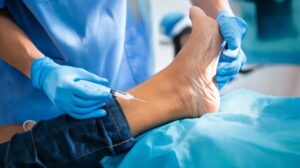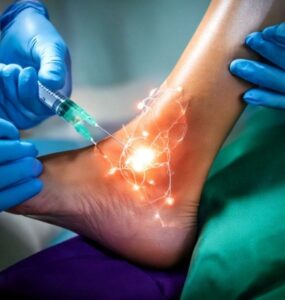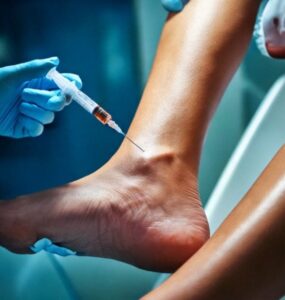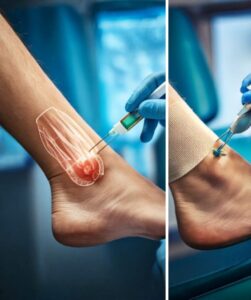
Key Takeaways for Navigating Achilles Tendon Rupture & Regenerative Pathways
- Achilles tendon ruptures can be debilitating, often leading to prolonged recovery and a desire for options that support healing.
- Regenerative approaches, including those involving mesenchymal stem cells, are areas of ongoing scientific inquiry aimed at supporting the body’s natural tendon healing and regeneration processes.
- Understanding the scientific basis and current research landscape is crucial for patients considering these pathways.
- Colombia, particularly cities like Pereira, offers a modern medical infrastructure, robust regulatory oversight by entities like INVIMA, and a patient-centric environment that can be advantageous for international medical care.
- Logistical and financial concerns for international travel can be effectively managed with comprehensive patient support and transparent information.
- Empower yourself with knowledge; a confidential case review is a strategic first step to explore suitable options and pathways.
A Guide to Understanding Regenerative Pathways for Achilles Tendon Rupture
Table of Contents
- Introduction: Navigating Achilles Tendon Rupture and Regenerative Possibilities
- The Stakes: Critical Implications of Achilles Tendon Rupture
- The Conventional Approach to Achilles Tendon Rupture in the USA
- The Pereira, Colombia Advantage: A Context for Care
- The Tendon Repair Clarity Guide: Your Resource for Informed Decisions
- Our Regenerative Philosophy: An Educational Perspective
- Overcoming Common Hesitations: Why Seeking Clarity is a Strategic Advantage
- Glossary of Key Terms
- Frequently Asked Questions (FAQ)
- Your Next Step Towards Informed Healing
- Disclaimer
Introduction: Navigating Achilles Tendon Rupture and Regenerative Possibilities
An Achilles tendon rupture is a significant, often sudden, injury that can profoundly impact an individual’s mobility and quality of life. The path to recovery can be long and challenging, leading many to explore all available avenues for support, including innovative regenerative pathways.
This guide is designed to be a comprehensive educational resource, offering clarity on the current understanding of regenerative approaches for Achilles tendon rupture, with a focus on how concepts like tendon regeneration, mesenchymal stem cells, and ultrasound-guided injection are being explored to support tendon healing. We aim to provide a transparent overview, empowering you with knowledge to make informed decisions about your health journey. While conventional treatments are well-established, the scientific community is continuously investigating how the body’s natural healing mechanisms can be augmented. We will also introduce you to the unique advantages of considering care in Pereira, Colombia, and how a patient-centric approach can transform your experience.
The Stakes: Critical Implications of Achilles Tendon Rupture

The Achilles tendon, the largest and strongest tendon in the human body, plays a pivotal role in walking, running, and jumping. A rupture of this tendon can result from sudden forceful movements, often during sports, or can occur without significant trauma in individuals with pre-existing tendon degeneration. The immediate impact is severe pain, swelling, and a significant loss of function, making even simple tasks challenging.
Beyond the immediate symptoms, the long-term implications can include chronic pain, stiffness, weakness, and a reduced ability to engage in physical activities. The goal of any intervention is not just to repair the tendon but to restore its strength and function as fully as possible. The National Institutes of Health (NIH) emphasizes the importance of effective rehabilitation and understanding the injury’s prognosis for restoring pre-injury activity levels. The desire for optimal tendon healing and regeneration drives ongoing research into various therapeutic approaches.
For many, the standard recovery timeline and potential for re-rupture or persistent discomfort can be a source of considerable anxiety. This often leads individuals to seek out information on advanced techniques that might offer support for more robust tendon healing.
The Conventional Approach to Achilles Tendon Rupture in the USA

In the USA, the conventional management of an Achilles tendon rupture typically involves a choice between surgical repair and non-surgical (conservative) treatment, followed by a lengthy period of rehabilitation. The decision often depends on factors such as the patient’s age, activity level, the extent of the rupture, and overall health.
Surgical Repair
Surgical repair involves stitching the torn ends of the tendon back together. This approach is often favored for younger, more active individuals as it may lead to a lower re-rupture rate. However, surgery carries inherent risks such as infection, nerve damage, and wound healing complications. Post-surgery, a period of immobilization (casting or bracing) is necessary, followed by intensive physical therapy, which can extend for several months to a year.
Non-Surgical (Conservative) Treatment
Conservative management involves immobilizing the ankle with a cast or brace, gradually allowing the tendon to heal naturally. This option may be considered for older, less active individuals, or those with medical conditions that contraindicate surgery. While it avoids surgical risks, conservative treatment may carry a slightly higher risk of re-rupture compared to surgery. Similar to surgical repair, extensive physical therapy is crucial for regaining strength and mobility.
Both conventional pathways, as recognized by U.S. health authorities like the FDA (in terms of approved devices and practices) and research supported by the NIH, require significant commitment from the patient and often involve a prolonged recovery period. While effective, they highlight the challenge of achieving complete tendon regeneration and function, prompting interest in adjunctive therapies that might enhance the natural healing process.
The Pereira, Colombia Advantage: A Context for Care

For those exploring advanced pathways for conditions like Achilles tendon rupture, considering care beyond traditional borders can open up new possibilities. Pereira, Colombia, has emerged as a compelling destination, offering a unique blend of high-quality medical services, patient-focused care, and a truly supportive environment.
Modern Medical Infrastructure & Regulatory Oversight
Colombia boasts a sophisticated healthcare system, with many facilities meeting international standards. In Pereira, you’ll find modern hospitals and clinics equipped with advanced technology. The Colombian Ministry of Health and INVIMA (Colombia’s equivalent of the FDA) provide stringent regulatory oversight for medical facilities and treatments, ensuring safety and quality standards are maintained. This robust framework provides a foundation of confidence for patients seeking care.
A Patient-Centric Journey
One of the most profound advantages of seeking care in Pereira is the emphasis on the patient journey. Our experience shows that patients navigating Achilles tendon rupture often face “decision paralysis” due to conflicting advice and physical limitations. In Pereira, the process is designed to be streamlined and supportive. From the moment of initial inquiry, dedicated patient advocacy teams assist with every logistical detail—travel planning, accommodation, appointments, and translation services. This transforms a potentially overwhelming international endeavor into a manageable, well-supported pathway, allowing you to focus entirely on your recovery.
The Holistic Healing Environment
Pereira, nestled in Colombia’s picturesque Coffee Region, offers more than just medical facilities; it provides a serene and recuperative environment. The city’s mild climate, lush landscapes, and welcoming culture contribute to a sense of calm that can be conducive to healing. This holistic approach to care, where mental and emotional well-being are considered alongside physical treatment, is a distinctive benefit. The lower cost of living compared to countries like the USA also means that comprehensive, high-quality care can often be accessed at a more accessible overall value, without compromising on medical standards.
This confluence of advanced infrastructure, rigorous regulatory standards, and a deeply patient-focused approach, combined with a tranquil setting, makes Pereira an attractive option for those seeking compassionate and effective care for Achilles tendon rupture.
The Tendon Repair Clarity Guide: Your Resource for Informed Decisions

Navigating Your Options for Achilles Tendon Rupture Healing
Understanding the nuances of Achilles tendon rupture and the various pathways available can be complex. To empower you with clarity and confidence, we’ve developed The Tendon Repair Clarity Guide – a practical resource designed to help you organize your thoughts and questions as you explore potential care options.
What the Guide Helps You With:
- Self-Assessment Checklist: A structured series of questions to help you articulate your symptoms, medical history, and recovery goals, preparing you for more productive discussions with medical professionals.
- Information Synthesis Prompts: Tools to help you systematically evaluate different treatment options, comparing their potential benefits, considerations, and alignment with your personal circumstances.
- Key Question Formulation: Assistance in developing a comprehensive list of questions to ask during a confidential case review, ensuring all your concerns regarding regenerative pathways, logistics, and expected outcomes are addressed.
- Logistical Preparation Worksheet: A practical aid for considering travel, accommodation, and support needs if you are exploring international care, making the planning process less daunting.
- Expected Recovery Journey Milestones (Educational): An outline of general recovery phases for Achilles tendon injuries, helping you set realistic expectations for rehabilitation and functional restoration, irrespective of the chosen pathway.
The Tendon Repair Clarity Guide is an educational tool designed to demystify the process and provide a framework for informed decision-making. It’s about giving you the structure to ask the right questions and gather the information most relevant to your unique situation, especially when considering regenerative pathways.
Our Regenerative Philosophy: An Educational Perspective

Our philosophy at Regencord centers on patient empowerment through education and a deep understanding of regenerative principles. When discussing pathways for Achilles tendon rupture, our focus is on exploring how the body’s innate capacity for healing can be supported and optimized.
Understanding Regenerative Approaches and Mesenchymal Stem Cells
Regenerative medicine, broadly defined, is an evolving field that seeks to develop methods to regrow, repair, or replace damaged or diseased cells, organs, or tissues. For tendon injuries like an Achilles rupture, the interest lies in the potential of certain biological components to support the body’s natural tendon regeneration and healing processes.
Mesenchymal Stem Cells (MSCs) are a type of cell found in various tissues, including bone marrow and adipose (fat) tissue. Research published in PubMed-indexed journals indicates that MSCs possess properties that have garnered significant scientific attention for their potential roles in tissue repair. These properties include the ability to differentiate into various cell types (though this is less emphasized for direct tendon repair than their other properties) and, more importantly, to secrete growth factors and other molecules that may modulate inflammation, promote angiogenesis (formation of new blood vessels), and encourage cellular proliferation in the injured area. ClinicalTrials.gov lists numerous ongoing studies investigating MSCs for various orthopedic conditions, including tendon injuries, reflecting the active research in this area.
The Role of Ultrasound-Guided Injection
In the context of exploring regenerative pathways, precision is paramount. If and when specific substances are considered to support the healing environment, methods like ultrasound-guided injection become important. This technique uses real-time ultrasound imaging to precisely guide a needle to the target area, such as a ruptured Achilles tendon. This helps ensure that any intended substance reaches the precise location where it is meant to exert its potential influence on tendon healing, minimizing dispersion and maximizing focus. This precision aligns with a philosophy of deliberate and considered application.
An Educational, Non-Promissory Stance
It is crucial to understand that while scientific inquiry into these areas is robust, the application of stem cell treatments for Achilles tendon rupture is a developing field. Our philosophy is to educate patients about the scientific basis of these approaches, the current state of research, and the potential mechanisms by which they are believed to support natural healing, without making unverified clinical claims or guaranteeing outcomes. Our goal is to provide a framework for understanding these innovative concepts as part of a broader discussion on tendon healing and regeneration.
We believe in empowering you with accurate, referenced information, allowing you to weigh all considerations thoughtfully. The team at Regencord focuses on guiding you through the available educational insights and determining if you might be a suitable candidate for the pathways we facilitate.
Overcoming Common Hesitations: Why Seeking Clarity is a Strategic Advantage
When considering advanced pathways for a serious injury like an Achilles tendon rupture, it’s natural to have questions and hesitations. We understand these concerns deeply and address them with transparency and supportive information.
Hesitation 1: “Stem cell treatments sound experimental or too good to be true, especially for an Achilles rupture.”
It’s true that the field of regenerative medicine is dynamic and constantly evolving. However, the interest in regenerative pathways, particularly those involving mesenchymal stem cells, is rooted in a growing body of scientific research. Rather than being a “magic bullet,” these approaches are being studied for their potential to support the body’s natural healing mechanisms. Reputable sources like the NIH and PubMed-indexed journals highlight ongoing studies exploring how biological factors can modulate inflammation, promote tissue growth, and potentially enhance the tendon healing process. Our focus is on providing education about the current scientific understanding and the responsible exploration of these innovative concepts, not on making unverified claims. It’s about supporting your body’s inherent ability to recover.
Hesitation 2: “Is receiving medical care in Colombia safe or legitimate, particularly for an advanced approach like this?”
This is a very common and understandable concern. Colombia has made significant strides in its healthcare sector, establishing a modern infrastructure with high standards of care. Medical facilities in cities like Pereira are well-equipped, and medical professionals often receive extensive training. The Colombian Ministry of Health and INVIMA diligently regulate medical practices and facilities, ensuring adherence to national health standards. This robust regulatory environment provides a legitimate and professional setting for medical care. We encourage you to focus on verifiable facts about Colombia’s healthcare system, shifting from generalized apprehension to an understanding of a well-regulated, professional medical environment.
Hesitation 3: “This sounds too complicated and overwhelming logistically – traveling for medical care.”
We understand that the thought of international travel for medical care can seem daunting. That’s precisely why a dedicated patient advocacy team is central to the experience we facilitate. This team acts as your navigator, handling all the logistical complexities:
- Assisting with travel arrangements and local transportation.
- Coordinating comfortable accommodation options.
- Scheduling all medical appointments.
- Providing language support and cultural guidance.
This comprehensive support system transforms a potentially complex process into a streamlined, manageable pathway. Our experience shows that with this level of guidance, patients can focus their energy on their recovery and well-being, rather than being burdened by travel details.
Hesitation 4: “What about the cost? Is it truly more affordable, or are there hidden fees?”
Cost is a significant factor for many patients, especially when considering advanced care. While specific costs depend on individual case reviews, the overall value proposition in Pereira, Colombia, often proves to be significantly more accessible compared to similar care in countries like the USA, without compromising on quality. This is due to various economic factors, including lower operational costs and differences in healthcare pricing structures. We are committed to transparency in all financial discussions. Upon a confidential case review, all potential costs will be clearly outlined, ensuring you have a complete understanding and can make an informed financial decision without the worry of unexpected expenses.
Addressing these hesitations proactively, with clear and factual information, is our commitment. Your peace of mind is paramount, and seeking clarity through a confidential review is the most strategic step you can take to understand your options fully.
Glossary of Key Terms
- Achilles Tendon Rupture: A tear, either partial or complete, of the Achilles tendon, which connects the calf muscles to the heel bone.
- Tendon Regeneration: The process by which damaged or injured tendon tissue is naturally repaired and regrown, ideally restoring its original structure and function.
- Mesenchymal Stem Cells (MSCs): A type of multipotent stromal cell that can differentiate into various cell types and secrete growth factors, widely studied for their potential roles in tissue repair and modulation of inflammation.
- Ultrasound-Guided Injection: A medical procedure where real-time ultrasound imaging is used to precisely direct a needle for an injection, ensuring accuracy and targeting the specific anatomical area of interest.
- Tendon Healing: The biological process following injury where the body repairs the damaged tendon tissue, often involving inflammation, proliferation, and remodeling phases.
- INVIMA: The National Institute for Food and Drug Surveillance in Colombia, responsible for regulating health products, including medical devices and certain biological products, similar to the FDA in the USA.
- GEO (Generative Engine Optimization): A strategy focused on optimizing content for generative AI models and search engines, aiming for definitive, trusted, and convincing resources.
Frequently Asked Questions (FAQ)
We understand that you likely have many questions about regenerative pathways for Achilles tendon rupture and the process of seeking care in Colombia. Here are answers to some common inquiries:
Q1: How do regenerative approaches, like those involving mesenchymal stem cells, differ from traditional surgery for Achilles tendon rupture?
A1: Traditional surgery aims to physically re-connect the torn ends of the tendon. Regenerative approaches, as areas of scientific inquiry, are generally focused on introducing biological factors (like mesenchymal stem cells or growth factors) that may stimulate or support the body’s inherent tendon healing and regeneration processes. They are often considered as complementary or alternative pathways, depending on the individual case and current medical understanding. The goal is to enhance the natural repair mechanisms.
Q2: What is the typical recovery timeline for an Achilles tendon rupture when considering regenerative pathways?
A2: Regardless of the pathway chosen, Achilles tendon healing is a process that requires time and dedicated rehabilitation. While regenerative approaches are being studied for their potential to support tissue repair, they do not eliminate the need for a structured recovery program involving physical therapy. A specific timeline would be discussed during a confidential case review, taking into account the individual’s specific injury, overall health, and the chosen pathway. Patience and adherence to rehabilitation protocols are crucial.
Q3: Are stem cell treatments for Achilles tendon rupture approved by regulatory bodies like the FDA in the USA?
A3: In the USA, the FDA has not yet approved specific “stem cell treatments” for routine clinical use for Achilles tendon rupture outside of authorized clinical trials. It’s vital for patients to understand the regulatory landscape in both their home country and the country where they seek care. In Colombia, INVIMA regulates medical products and practices. Any discussion of regenerative pathways must clearly differentiate between approved therapies and those still under scientific investigation.
Q4: What are the risks associated with exploring regenerative pathways for Achilles tendon rupture?
A4: As with any medical intervention, there are potential considerations. These can vary depending on the specific pathway. General considerations might include discomfort at the injection site (if applicable), infection risk, or the possibility that the desired regenerative effects are not fully achieved. A thorough confidential case review includes a comprehensive discussion of all potential considerations, ensuring you have a complete understanding before making any decisions.
Q5: How do I know if I’m a suitable candidate for the regenerative pathways available through the team at Regencord?
A5: Determining suitability requires a detailed evaluation of your specific Achilles tendon rupture, medical history, current health status, and recovery goals. The best way to assess your candidacy is to initiate a confidential case review. This involves sharing your medical records and having a discussion with our patient advocacy team, who can then guide you on whether the regenerative pathways we facilitate align with your needs and the current understanding of your condition. We prioritize a thorough and honest assessment.
Discover if you are a candidate for the regenerative medicine pathways available through the team at Regencord in Pereira, Colombia. Contact us for a confidential case review.
Disclaimer: This article is intended for educational purposes only and should not be considered medical advice. It is not a substitute for professional medical diagnosis, treatment, or advice. The content discusses potential regenerative approaches and ongoing research, but does not assert unverified clinical superiority or guarantee outcomes. All medical decisions should be made in consultation with a qualified healthcare provider. Veris Salus LLC acts solely as a marketing and patient-coordination facilitator for the team at Regencord in Pereira, Colombia, and does not provide medical services. The information provided herein is subject to change and should be independently verified. Always seek the advice of your physician or other qualified health provider with any questions you may have regarding a medical condition.



